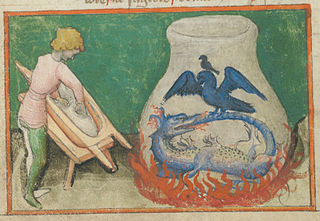
Alchemy is an ancient branch of natural philosophy, a philosophical and protoscientific tradition that was historically practised in China, India, the Muslim world, and Europe. In its Western form, alchemy is first attested in a number of pseudepigraphical texts written in Greco-Roman Egypt during the first few centuries AD.

Alexander of Hales, also called Doctor Irrefragibilis and Theologorum Monarcha, was a Franciscan friar, theologian and philosopher important in the development of scholasticism.
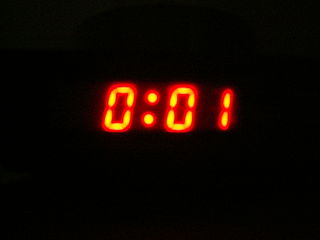
The minute is a unit of time defined as equal to 60 seconds. One hour contains 60 minutes. Although not a unit in the International System of Units (SI), the minute is accepted for use in the SI. The SI symbol for minutes is min. The prime symbol ′ is also sometimes used informally to denote minutes. In the UTC time standard, a minute on rare occasions has 61 seconds, a consequence of leap seconds; there is also a provision to insert a negative leap second, which would result in a 59-second minute, but this has never happened in more than 40 years under this system.

Pope Clement IV, born Gui Foucois and also known as Guy le Gros, was bishop of Le Puy (1257–1260), archbishop of Narbonne (1259–1261), cardinal of Sabina (1261–1265), and head of the Catholic Church from 5 February 1265 until his death. His election as pope occurred at a conclave held at Perugia that lasted four months while cardinals argued over whether to call in Charles I of Anjou, the youngest brother of Louis IX of France, to carry on the papal war against the Hohenstaufens. Pope Clement was a patron of Thomas Aquinas and of Roger Bacon, encouraging Bacon in the writing of his Opus Majus, which included important treatises on optics and the scientific method.

Roger Bacon, also known by the scholastic accolade Doctor Mirabilis, was a medieval English philosopher and Franciscan friar who placed considerable emphasis on the study of nature through empiricism. In the early modern era, he was regarded as a wizard and particularly famed for the story of his mechanical or necromantic brazen head. He is sometimes credited as one of the earliest European advocates of the modern scientific method, along with his teacher Robert Grosseteste. Bacon applied the empirical method of Ibn al-Haytham (Alhazen) to observations in texts attributed to Aristotle. Bacon discovered the importance of empirical testing when the results he obtained were different from those that would have been predicted by Aristotle.
Year 1267 (MCCLXVII) was a common year starting on Saturday of the Julian calendar.

A camera obscura is a darkened room with a small hole or lens at one side through which an image is projected onto a wall or table opposite the hole. The image of lensless camera obscuras is also referred to as "pinhole image".

Robert Grosseteste, also known as Robert Greathead or Robert of Lincoln, was an English statesman, scholastic philosopher, theologian, scientist and Bishop of Lincoln. He was born of humble parents in Suffolk, but the associations with the village of Stradbroke is a post-medieval tradition. Upon his death, he was revered as a saint in England, but attempts to procure a formal canonisation failed. A. C. Crombie called him "the real founder of the tradition of scientific thought in medieval Oxford, and in some ways, of the modern English intellectual tradition". As a theologian, however, he contributed to increasing hostility to Jews and Judaism, and spread the accusation that Jews had purposefully suppressed prophetic knowledge of the coming of Christ, through his translation of the Testaments of the Twelve Patriarchs.
The following outline is provided as an overview of and topical guide to the scientific method:

Vitello was a Polish friar, theologian, natural philosopher and an important figure in the history of philosophy in Poland.
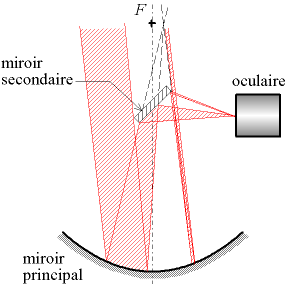
Catoptrics deals with the phenomena of reflected light and image-forming optical systems using mirrors. A catoptric system is also called a catopter (catoptre).
Artephius is a writer to whom a number of alchemical texts are ascribed. Although the roots of the texts are unclear and the identity of their author obscure, at least some of them are Arabic in origin. He is named as the author of several books, the Ars sintrillia, Clavis sapientiae or Clavis maioris sapientiae, and Liber secretus.
The history of scientific method considers changes in the methodology of scientific inquiry, as distinct from the history of science itself. The development of rules for scientific reasoning has not been straightforward; scientific method has been the subject of intense and recurring debate throughout the history of science, and eminent natural philosophers and scientists have argued for the primacy of one or another approach to establishing scientific knowledge.
David Charles Lindberg was an American historian of science. His main focus was in the history of medieval and early modern science, especially physical science and the relationship between religion and science. Lindberg was the author or editor of many books and received numerous grants and awards. He also served as president of the History of Science Society and in 1999 was the recipient of its Sarton medal.
Events from the 1260s in England.
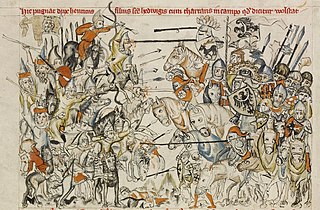
Puresh was a Moksha Kanazor, ruler of Kingdom Moxel in mentioned in Russians sources as Murunza. He was an ally of Russian Grand Prince Yuri II of Vladimir and of the Cuman Khan Köten against the Volga Bulgars and Erzyas in the 1230s.

The Mirror of Alchimy is a short alchemical manual, known in Latin as Speculum Alchemiae. Translated in 1597, it was only the second alchemical text printed in the English language. Long ascribed to Roger Bacon (1214-1294), the work is more likely the product of an anonymous author who wrote between the thirteenth and the fifteenth centuries.
The Summa Grammatica was one of the earlier works on Latin grammar and Aristotelian logic by the medieval English philosopher Roger Bacon. It is primarily noteworthy for its exposition of a kind of universal grammar.
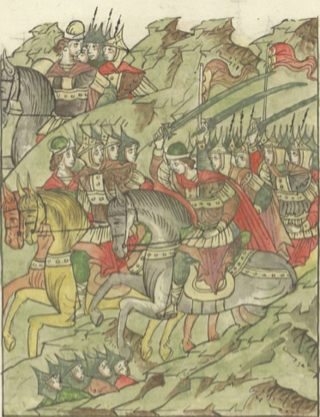
Atämaz was a Moxel prince of 13th c. He was the son of Kanazor (King) Puresh and brother of Queen Narchat.















